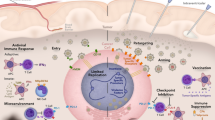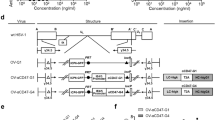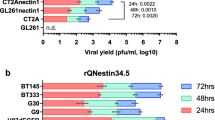Abstract
Here we developed an effective therapeutic approach using a replication-conditional mutant of herpes simplex virus (HSV), G207, for the treatment of metastatic tumors in the immunologically privileged central nervous system. An experimental model of brain metastasis was developed using BALB/c mice that harbored both intracranial (i.c.) and subcutaneous (s.c.) mouse CT26 colon adenocarcinoma tumors. Intratumoral injections of G207 into s.c. tumors elicited cytotoxic T-cell responses not only to HSV but also to a tumor antigen; however, only a limited antitumor effect was observed on metastatic brain tumors. To improve this antitumor effect, G207 was also injected into the brain tumor. After intratumoral injections of G207 into both i.c. and s.c. CT26 tumors, a significant antitumor effect was observed in the metastatic brain tumors. This therapeutic efficacy was absent in athymic mice, indicating that the antitumor effect could be mediated by T cells. Cytotoxic T-cell responses to HSV and the tumor antigen were induced by injections of G207 into i.c. and s.c. CT26 tumors. These results suggest that HSV-infected brain tumors may be efficiently eliminated by the induced anti-HSV T cells as well as by antitumor T cells. Therefore, this strategy of immuno-viral therapy, involving direct viral oncolytic activities and inducing antitumor and antiviral immune responses, may be useful for the treatment of tumors in the immunologically privileged central nervous system.
This is a preview of subscription content, access via your institution
Access options
Subscribe to this journal
Receive 12 print issues and online access
$259.00 per year
only $21.58 per issue
Buy this article
- Purchase on Springer Link
- Instant access to full article PDF
Prices may be subject to local taxes which are calculated during checkout







Similar content being viewed by others
References
Wekerle H . T-cell autoimmunity in the central nervous system Intervirology 1993 35: 95–100
Fabry Z, Raine CS, Hart MN . Nervous tissue as an immune compartment: the dialect of the immune response in the CNS Immunol Today 1994 15: 218–224
Zeine R, Owens T . Direct demonstration of the infiltration of murine central nervous system by Pgp-1/CD44 high CD45RB(low) CD4+ T cells that induce experimental allergic encephalomyelitis J Neuroimmunol 1992 40: 57–69
Mineta T, Rabkin SD, Yazaki T et al. Attenuated multi-mutated herpes simplex virus-1 for the treatment of malignant gliomas Nat Med 1995 1: 938–943
Yazaki T, Manz HJ, Rabkin SD et al. Treatment of human malignant meningiomas by G207, a replication-competent multimutated herpes simplex virus 1 Cancer Res 1995 55: 4752–4756
Toda M, Rabkin SD, Martuza RL . Treatment of human breast cancer in a brain metastatic model by G207, a replication-competent multimutated herpes simplex virus 1 Hum Gene Ther 1998 9: 2177–2185
Todo T, Rabkin SD, Sundaresan P et al. Systemic antitumor immunity in experimental brain tumor therapy using a multimutated, replication-competent herpes simplex virus Hum Gene Ther 1999 10: 2741–2755
Todo T, Rabkin SD, Chahlavi A et al. Corticosteroid administration does not affect viral oncolytic activity, but inhibits antitumor immunity in replication-competent herpes simplex virus tumor therapy Hum Gene Ther 1999 10: 2869–2878
Markert JM, Medlock MD, Rabkin SD et al. Conditionally replicating herpes simplex virus mutant, G207 for the treatment of malignant glioma: results of a phase I trial Gene Ther 2000 7: 867–874
Toda M, Rabkin SD, Kojima H et al. Herpes simplex virus as an in situ cancer vaccine for the induction of specific anti-tumor immunity Hum Gene Ther 1999 10: 385–393
Toda M, Martuza RL, Kojima H et al. In situ cancer vaccination: an IL-12 defective vector/replication-competent herpes simplex virus combination induces local and systemic antitumor activity J Immunol 1998 160: 4457–4464
Toda M, Martuza RL, Rabkin SD . Tumor growth inhibition by intratumoral inoculation of defective herpes simplex virus vectors expressing granulocyte–macrophage colony-stimulating factor Mol Ther 2000 2: 324–329
Toda M, Martuza RL, Rabkin SD . Combination suicide/cytokine gene therapy as adjuvants to a defective herpes simplex virus–based cancer vaccine Gene Ther 2001 8: 332–339
Zimm S, Wampler GL, Stablein D et al. Intracerebral metastases in solid-tumor patients: natural history and results of treatment Cancer 1981 48: 384–394
Patchell RA . Brain metastases Neurol Clin 1991 9: 817–824
Penar PL, Wilson JT . Cost and survival analysis of metastatic cerebral tumors treated by resection and radiation Neurosurgery 1994 34: 888–893
Auchter RM, Lamond JP, Alexander E et al. A multi-institutional outcome and prognostic factor analysis of radiosurgery for resectable single brain metastasis Int J Radiat Oncol 1996 35: 27–35
Bindal AK, Bindal RK, Hess KR et al. Surgery versus radiosurgery in the treatment of brain metastasis J Neurosurg 1996 84: 748–754
Bindal RK, Sawaya R, Leavens ME et al. Surgical treatment of multiple brain metastases J Neurosurg 1993 79: 210–216
Schackert HK, Itaya T, Schackert G et al. Systemic immunity against a murine colon tumor (CT-26) produced by immunization with syngeneic cells expressing a transfected viral gene product Int J Cancer 1989 43: 823–827
Endo T, Toda M, Watanabe M et al. In situ cancer vaccination with a replication-conditional HSV for the treatment of liver metastasis of colon cancer Cancer Gene Ther 2002 9: 142–148
Toda M, Iizuka Y, Yazaki T et al. In situ cancer vaccination using a mutant HSV-1 for the treatment of metastatic brain tumor Neuro-Oncology 1999 1: S105
Brattain MG, Strobel-Stevens J, Fine D et al. Establishment of mouse colonic carcinoma cell lines with different metastatic properties Cancer Res 1980 40: 2142–2146
Plaut M, Lichtenstein LM, Gillespie E et al. Studies on the mechanism of lymphocyte-mediated cytolysis: IV. Specificity of the histamine receptor on effector T cells J Immunol 1973 111: 389–394
Alfieri AA, Hahn EW . An in situ method for estimating cell survival in a solid tumor Cancer Res 1978 38: 3006–3011
Hitsumoto Y, Sonoda S, Okuyama M et al. Preparation of membrane fraction from herpes simplex virus–infected cells which induce cytotoxic T lymphocytes Microbiol Immunol 1983 27: 757–765
Huang AYC, Gulden PH, Woods AS et al. The immunodominant major histocompatibility complex class I–restricted antigen of a murine colon tumor derives from an endogenous retroviral gene product Proc Natl Acad Sci USA 1996 93: 9730–9735
Van den Eynde B, Lethe B, Van Pel A et al. The gene coding for a major tumor rejection antigen of tumor P815 is identical to the normal gene of syngeneic DBA/2 mice J Exp Med 1991 173: 1373–1384
Becher B, Prat A, Antel JP . Brain–immune connection: immuno-regulatory properties of CNS-resident cells Glia 2000 29: 293–304
Irani DN, Lin KI, Griffin DE . Regulation of brain-derived T cells during acute central nervous system inflammation JImmunol 1997 158: 2318–2326
Irani DN . Brain-derived gangliosides induce cell cycle arrest in a murine T cell line J Neuroimmunol 1998 87: 11–16
Fearon ER, Itaya T, Hunt B et al. Induction in a murine tumor of immunogenic tumor variants by transfection with a foreign gene Cancer Res 1988 35: 2975–2980
Wang M, Bronte V, Chen PW et al. Active immunotherapy of cancer with a nonreplicating recombinant fowlpox virus encoding a model tumor-associated antigen J Immunol 1995 154: 4685–4692
Roth C, Rochlitz C, Kourilsky P . Immune response against tumors Adv Immunol 1994 57: 281–351
Kovacsovics-Bankowski M, Rock KL . A phagosome-to-cytosol pathway for exogenous antigens presented on MHC class I molecules Science 1995 267: 243–246
Reis e Sousa C, Germain RN . Major histocompatibility complex class I presentation of peptides derived from soluble exogenous antigen by a subset of cells engaged in phagocytosis J Exp Med 1995 182: 841–851
Jackson AC, Moench TR, Trapp BD et al. Basis of neurovirulence in Sindbis virus encephalomyelitis of mice Lab Invest 1988 58: 503–509
Whitley RJ . Herpes simplex viruses In: Fields BN, Knipe DM, Howley PM, eds Fields Virology third edition vol. 2: Philadelphia: Lippincott-Raven 1996 2297–2342
Martuza RL . Conditionally replicating herpes vectors for cancer therapy J Clin Invest 2000 105: 841–846
Acknowledgements
We thank Robert L Martuza and Samuel D Rabkin (Harvard Medical School) for critical comments on the manuscript, and Wangjie Yu for technical assistance. This study was supported, in part, by grants from the Ministry of Education, Science, Sports, and Culture in Japan, the Human Science Foundation, the Mochida Memorial Foundation for Medical and Pharmaceutical Research, and the Keio Gijuku Academic Development Funds.
Author information
Authors and Affiliations
Corresponding author
Rights and permissions
About this article
Cite this article
Toda, M., Iizuka, Y., Kawase, T. et al. Immuno-viral therapy of brain tumors by combination of viral therapy with cancer vaccination using a replication-conditional HSV. Cancer Gene Ther 9, 356–364 (2002). https://doi.org/10.1038/sj.cgt.7700446
Published:
Issue Date:
DOI: https://doi.org/10.1038/sj.cgt.7700446
Keywords
This article is cited by
-
Immune-resistant mechanisms in cancer immunotherapy
International Journal of Clinical Oncology (2020)
-
Pediatric cancer gone viral. Part I: strategies for utilizing oncolytic herpes simplex virus-1 in children
Molecular Therapy - Oncolytics (2015)
-
Downregulation of KIF23 suppresses glioma proliferation
Journal of Neuro-Oncology (2012)
-
Thunder and Lightning: Immunotherapy and Oncolytic Viruses Collide
Molecular Therapy (2011)



